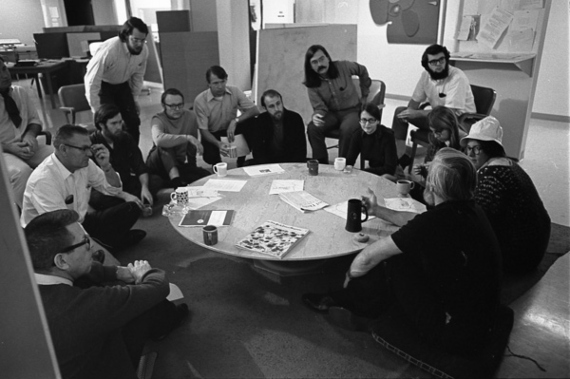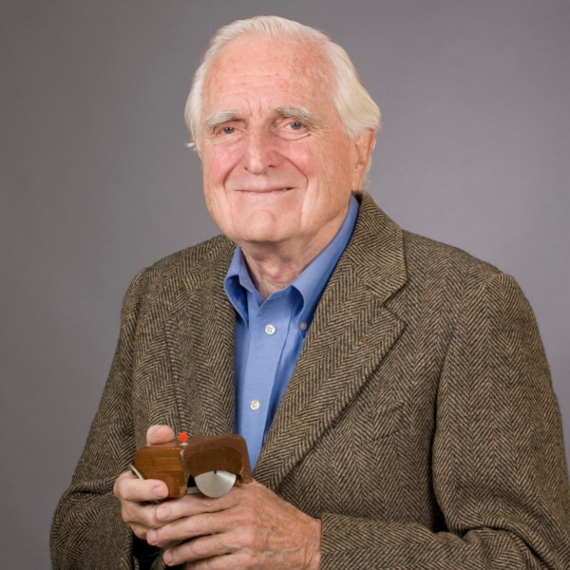Douglas Engelbart’s name will have little resonance except amongst those most familiar with new technologies. For the rest, it will not be remotely comparable to the names of Steve Jobs or Bill Gates. And yet, these two figures would not be what they are today if there had not been a Douglas Engelbart, or perhaps if he had not read the July 1945 issue of The Atlantic magazine while working as a radar technician in a hut in the Philippines. In fact, Engelbart not only invented much of the technology that we cannot do without today and that, among other things, taught us to talk to machines —even to his own dismay— but he also pioneered the Jobs-style presentations that are now so popular. But his was not just another demo, but one that would later go down in history as “The Mother of All Demos.”
The younger years of Engelbart (30 January 1925 – 2 July 2013) paint an almost perfect portrait of him: in 1950, aged 25 and engaged to his future wife, he was working at the Ames Research Center of NACA (now NASA) and had no other goals in life beyond a steady job, getting married and living happily, as he told The Mercury News in 1999. He was a simple, average American raised on a farm, not a charismatic garage entrepreneur with dreams of fame and money. But he was by no means lacking in ambition, quite the opposite; when he swapped Ames for UC Berkeley in 1950, he was plotting what would become his self-confessed life’s goal: nothing less than to harness the full power of the human intellect to solve the world’s great problems and make it a better place.
A research center for augmenting human intellect
His way to achieve this was with computers. Five years earlier, while working as a radio and radar technician for the Navy on a small Philippine island, he had read a magazine article entitled As We May Think, written by the then director of the Office of Scientific Research and Development and presidential adviser, Vannevar Bush. The article unpacked the theoretical invention of the Memex, a machine that would store all human knowledge and navigate through it by following a trail of links from one source to another. That early vision of what we would later come to know as the Internet was a powerful influence on many engineers and computer scientists of the time, and on young Engelbart.
So Engelbart began to think and invent. From his early days at Berkeley to his later work at the Stanford Research Institute, he developed a series of innovations that he would finally showcase together on 9 December 1968, during a 90-minute presentation to a thousand attendees at the Fall Joint Computer Conference in San Francisco. The talk was presented under the title “A research center for augmenting human intellect,” during which Engelbart unveiled the so-called oN-Line System (NLS).

The NLS was a complete system of hardware and software that included such innovations as the computer mouse (patented by him as “an X-Y position indicator for a display system”), the graphic interface, multiple windows, hypertext, navigation, word processing, integration of images and videos, and online collaborative work. In other words, practically everything that today essentially defines the way we use our computers. And to top it all off, all of this through a multiple videoconference presentation, given that at the time it was difficult to move the large, heavy computers to the auditorium to operate them in situ.
This “mother of all demos,” as the journalist Steven Levy dubbed it in 1994 and about which a musical has even been created, transformed the image of Engelbart that was then widespread in the computing community, which saw him as a crackpot with eccentric visions. The lecture closed with a standing ovation, and commentary spoke of “Moses opening the Red Sea” and “dealing lightning with both hands.” However, its immediate impact was limited, as it would be years or decades before these ahead-of-their-time inventions became realities within the reach of users.
Against usability
Curiously, although the innovations created by Engelbart have taught us to talk to machines, opening up the use of computers and other devices to anyone without technical knowledge was never his intent. In fact, Engelbart disavowed what we now call usability or user-friendliness, even though it was precisely his work that drove the concept; his intention was not to bring machines to humans, but to bring humans to machines. He wanted to bring an end to computers being just huge calculators, by exploiting their full potential in a collaborative way to achieve his ultimate goal. And usability, he thought, limited the potential for productivity.

This explains why Jobs and Engelbart did not see eye to eye. Jobs learned about the mouse during a visit to Xerox PARC, where Engelbart’s former co-workers worked. The Apple co-founder enthusiastically embraced the idea of the device, which would become an essential hallmark of the Macintosh. But when Jobs explained his system to Engelbart in the 1980s, Engelbart was unimpressed. He did not understand the reason for a single-button mouse, when three would increase its capabilities, or why so much insistence on a personal computer, when the future of computing was a large peer-to-peer collaborative scheme. For Engelbart, Jobs’ computer was “like having an exotic office without a telephone or door.”
Clearly, time has proven Engelbart right, even if today usability is key. If there is one thing the profiles of this pioneer have in common, it is that his name is still not widely known today. He was not a marketing genius, but a “shy engineer”, as Smithsonian Magazine called him. But ultimately he did achieve his goal: he improved the world.
Javier Yanes
@yanes68
Comments on this publication